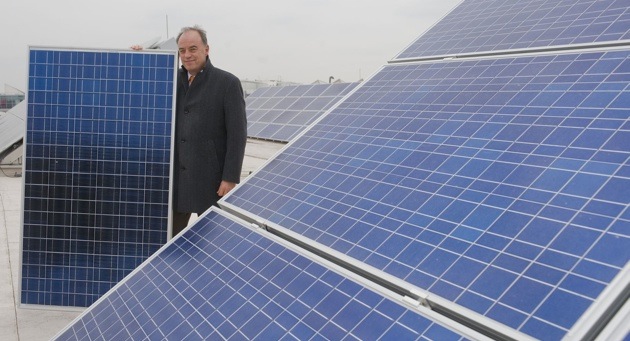
Automotive factories tend to be very large buildings, more often than not on a single level in order to aid internal logistics. A byproduct of such a configuration is a large, flat roof. Such a surface can be be ideally suited to the installation of solar power generation. With that in mind, Audi has decided that 124,861 square feet of roof space at its Ingoldstadt, Germany headquarters campus will be made available for the installation of photovoltaic cells.
The solar modules will be installed on the roofs of the toolmaking shop, the parking garage at the technical development center and one additional building. The installations are being performed by Münich-based Green City Energy and are expected to generate 1,000 MWh of electricity annually.
Audi is also considering solar installations at the Neckarsulm campus, its second-largest facility. Neckarsulm could get as much as 355,209 square feet for solar installations, all of which will help reduce Audi's manufacturing carbon footprint.
[Source: Audi]
press release
AUDI AG: solar power from factory roof
• Car manufacturer makes 11,600 square meters (124,861 square feet) of space available for photovoltaic systems at headquarters in Ingolstadt
• Practical testing of innovative technologies • Plant Manager Kössler: "A key part of our environmental strategy"
Ingolstadt (Germany), December 15, 2009 – AUDI AG sets new standards in the
field of photovoltaics. On its plant premises in Ingolstadt, the car manufacturer has made numerous roofs available for practical testing of innovative new technologies by the Munich-based company Green City Energy. Photovoltaic modules will be installed there over a surface area of 11,600 square meters (124,861 square feet) in the weeks ahead.
"We will generate more than 1,000 MWh of electricity this way each year, which equates to the consumption of 220 four-person households," explained Plant Manager Peter Kössler today at the installation of modules on the roof of the Toolmaking Shop. In addition to this area, photovoltaic panels will be installed on a parking deck at Technical Development and on another one to the south of the plant premises. These will already begin supplying the power grid in early 2010.
Four new types of modules will be used. Along with the structural aspect and the nature and angle of the roof, decisive factors for selection included the innovative qualities, efficiency and energy balance of the modules in particular. "With our commitment, we want to boost photovoltaics as a significant form of environmentally friendly energy production, while at the same time proving our 'Vorsprung durch Technik' in this field as well," emphasized Kössler.
This is a beacon project that should serve as a role model within the company. The installation of further modules – covering an area of 8,700 square meters (93,646 square feet) – is already planned for the Ingolstadt site. Altogether, the photovoltaic systems installed at headquarters will then produce 1,900 MWh of electricity.
Possibilities are also currently being reviewed for the other German Audi site in Neckarsulm. As early as next year, photovoltaic modules could cover a roof area of
33,000 square meters (355,209 square feet) there, with a total maximum output (under optimum conditions) of up to 2.0 MWp.
Kössler makes it clear: "The photovoltaic systems in Ingolstadt and Neckarsulm are a key part of our environmental strategy." In conjunction with its comprehensive efficiency strategy, Audi recently established an environmental foundation with an endowment of five million euros to support ecological projects that serve the public good.
One example of Audi's commitment to environmental issues is its increased usage of waste heat, based on a new agreement concluded with Ingolstadt's public utilities company at the end of September. The agreement provides for increasing the amount of district heat supplied each year to around 120,000 MWh, starting 2011. Last week, the research project "Oak Forest CO2 Reservoir" was launched, for which 36,000 oak trees were planted close to the plant premises. Together with the Bavarian State Forestry and the Chair of Forest Yield Science at the Technical University of Munich, Audi wants to research how the stand density of oak forests affects their productivity, biodiversity and CO2 sequestration potential. Trial locations near Györ, Hungary, and at other Audi sites around the world will follow the example of the pilot tract in the Kösching Forest outside of Ingolstadt.


Sign in to post
Please sign in to leave a comment.
Continue